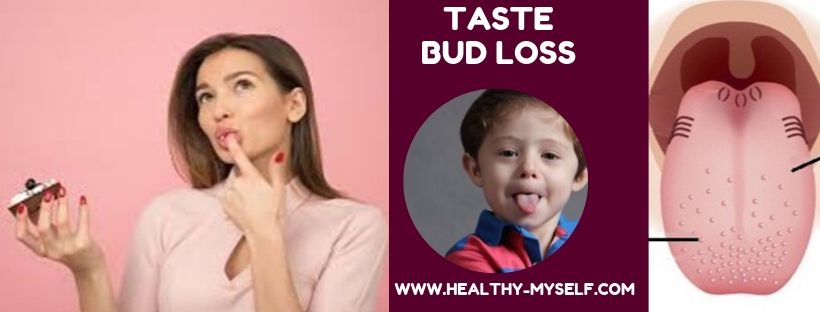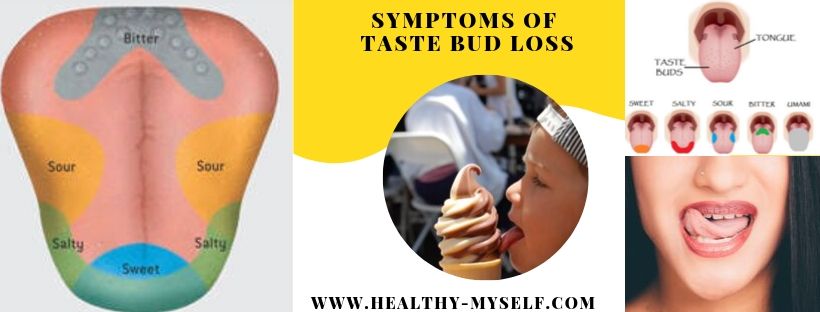Don’t Worry For Taste Buds Loss, Read This- [Awesome] 8 minutes Article and get Solution fastly!!
Taste Buds is your sense of taste and is connected with smell?
Can you taste any food?
What Are Taste Buds?
Any idea about Taste Bud loss?
When did you first notice the problem?
Is the problem getting worse?
Have you been told that you have allergies or chronic sinus problems?
What medicines do you take?
In healthy myself- I will share you about- Taste Buds & Taste Buds Loss.
stay with us for 6 minutes only…
Contents
1.Feel About Taste Buds:

Taste Buds https://healthy-myself.com/
It’s common to feel like you and can’t taste your food when you’re ill.
But have you ever wondered why that is?
The word taste and gustation, to give its full name.
It refers to what is detected by the taste cells and, located on the front and back of the tongue and on the sides, back and roof of the mouth.
These receptor cells and taste buds bind with molecules from the food.
And drink being consumed and send signals to the brain.
1.1. How exactly do your taste buds work?

Well, now stick out your tongue and look in the mirror.
See all those bumps?
Those are called(say: puh-PILL-ee), and most of them contain taste buds.
Taste buds have very sensitive microscopic hairs and it is called- microvilli.
Those tiny hairs send messages to the brain about the taste the something.
So you know of the taste of it whether it’s sweet, sour, bitter, or salty.
The average person has about 10,000 of taste buds and they’re replaced every 2 weeks or so.
1.2. Here’s how it works:
While you’re chewing and, the food releases chemicals that immediately travel up into your nose.
These chemicals trigger the olfactory receptors that are situated inside the nose.
So the next time you chomp on an apple and slurp up some soup, thank your tongue — and your nose!
Remember without them, life wouldn’t have any flavor.
2.Taste Buds on Tungs:

Taste Buds on Tungs https://healthy-myself.com/
The surface of our tongue is covered with tiny bumps called papillae, which contain our tastebuds and also some glands that help in the creation and secretion of saliva.
2.1.Cells Combination:
Tastebuds is a combination of cells like—basal cells, columnar cells, and between 10 and 50 taste receptor cells.
Which are renewed every 9-10 days automatically?
Some of these receptor cells contain proteins and they bind to some of the chemicals from our food.
Once the receptor has detected a particular chemical and, then this information is conveyed to the brain and, where taste is perceived.
The number of tastebuds people have can vary greatly.
The average adult has between 2000 and 8000 tastebuds—some people have fewer, larger tastebuds while others have many smaller tastebuds.
2.2.Different Foods and Taste Buds:
The TRPM8 protein is triggered when we eat any type of cold foods like- ice cream, then it’s also responsible for the cold feeling.
When we eat foods with menthol, mint and or eucalyptus flavors they will be active.
The TRP-V1 protein is activated by heat—a mouthful of hot soup, perhaps, but also by capsaicin (hot chilies), piperine (black pepper) and allyl isothiocyanate (hot mustard).
We can check the texture and consistency of the food—how it feels in our mouths?
It is also important – how we perceive its taste and whether we like it or not?
Scientists have spent a lot of time investigating the rheology and tribology to understand.
How these factors will affect people’s food preferences or choices.
The way we perceive taste is influenced by a whole range of different factors and, our tastebuds to our genes.
There’s a lot going on when you enjoy your morning cup of coffee or a deliciously salty chip.
On average, the human tongue has about 2,000–8,000 taste buds and implying that there are hundreds of thousands of receptor cells also.
However, the number of taste buds varies widely.
3.Types of taste Buds :
The receptors for sweet, bitter, sour and umami tastes are proteins i.e produced and coded for by particular genes in our DNA that found on the surface of the cells.
They react in the presence of certain chemicals, triggering a sequence of events resulting in the chemical message described above.
The salt receptor called the epithelial sodium channel and, is essentially a membrane.
Sodium ions are present in the cells in our bodies and help them.
But it’s not only the taste sensation on our tongues but also taste receptors found in our throat and in our gut.
Though these act in a slightly different way to those on our tongue also.
Hence, food smells are also important to our overall eating habits.
As we chew the food, volatile compounds are released and then travel from the back of our mouths to our noses and, where they stimulate our olfactory system.
Without this, much of the flavor of the food we’re eating is missed and, as opposed to just what is perceived by our tastebuds.
Whatever foods like carbohydrates, Protein may not get tastes.
There are other sensations besides taste and whatever that take place in our mouths.
3.1.Taste sensations:
As a result, the sensation of different tastes is like -salty, sweet, sour, bitter, and umami is not only within a single taste bud but also throughout the surface of the tongue area.
Did you ever wonder why your favorite foods taste is so good?
Well, you can thank your taste buds for letting the actual taste and the sweetness of lovely ice cream taste or any other masala taste also.
Taste buds are sensory organs and are found on your tongue that allows you to get tastes that are sweet, salty, sour, and bitter.
4.TasteBud Loss:

TasteBud Loss https://healthy-myself.com/
Here are some Data regarding Taste Bud Loss:
| Cause of taste disorder | Percent of patients |
| Head injury | 28\%28% |
| Radiation therapy | 12\%12% |
| Chemical exposure | 24\%24% |
| Surgeries to the ear, nose, and throat | 5\%5% |
| Poor oral hygiene and/or dental problems | 9\%9% |
| Upper respiratory and/or middle ear infection | 12\%12% |
5.Symptoms Of Taste Bud Loss:-

Symptoms Of Taste Bud Loss https://healthy-myself.com/
The alterations in the sense of taste usually a metallic taste, and sometimes smell are the only symptoms,get checked.
The duration of the symptoms of dysgeusia is depended on the cause.
If the alteration in the sense of taste is due to gum disease dental plaque a temporary medication, and a short-term condition.
Such as a cold the dysgeusia that should disappear once the cause is removed.
In some cases, if lesions are present in the taste pathway and nerves have been damaged then the dysgeusia may be permanent.
6.Causes of taste Bud Loss :
Some people are born with chemosensory disorders, and most develop them after an injury or illness.
Loss of taste can also be caused by exposure to certain harmful chemicals such as insecticides and by some medicines also.
Taste disorders may result from oral health problems and to some surgeries also.
Many patients who receive radiation therapy for cancers of the head or other organ and neck develop chemosensory disorders.
You can take this for your taste–

7.The link between taste and smell:

The senses of taste and smell are closely linked to each other.
The flavors in food can be tasted because of a combination of your ability to smell and taste.
In some cases, your taste buds may be functioning just fine, and your sense of smell is the problem.
Your doctor might send you to an ear, nose, and throat specialist, called an OTOLARYNGOLOGIST to determine if you have a smell disorder.
8.CONCLUSION:

Taste and smell disturbances affect the quality of life of a large proportion of patients.
Patients are often subjected to the unnecessary and sometimes irreversible and damaging treatment of teeth and other oral mucosal tissues.
Thus, proper oral examination and identification of the local factors can prevent unnecessary treatment by dentists.
You can read here also-
https://en.wikipedia.org/wiki/Taste_bud
- I think you have enjoyed this post a lot.
- Please share it with friends, family, colleagues, and partners.
- Make your valuable comments.

You are a very intelligent person!